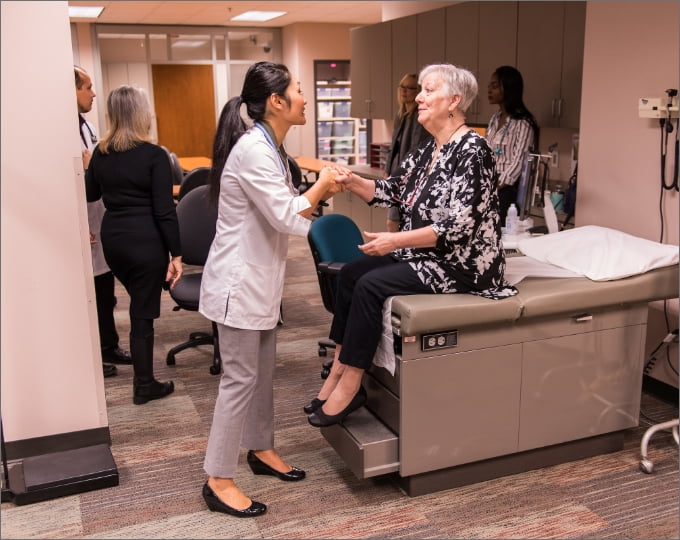
The Family Nurse Practitioner Role Explained: Interdisciplinary Collaboration
June 8, 2021What's the family nurse practitioner role in interdisciplinary teams?
As more health care settings shift to team-based models, you may be curious how family nurse practitioners (FNPs) work with other providers and staff.
Read on to learn how graduate nursing programs, such as the online MSN–FNP at Texas Woman's University, prepare FNPs for interdisciplinary care.
Plus, explore the function of FNPs on teams, the benefits of integrating FNPs on teams and the outlook for the family nurse practitioner role.
What's Interdisciplinary Health Care?
Interdisciplinary health care is synonymous with team-based care. The prevailing definition comes from the National Academy of Medicine (NAM).
Team-based care involves two or more health practitioners working together to serve individuals, families or their communities. The aim is to achieve coordinated, high-quality care. The practitioners work collaboratively with patients and their caregivers to accomplish shared goals.
NAM credits the shift to team-based care to the growing complexity of our health care system.
Here are just a few examples of its intricacy:
- Approximately 2,700 guidelines direct clinical practice.
- Every year, results of more than 25,000 new clinical trials are published.
- The typical Medicare patient sees two primary care clinicians, five specialists, plus other service providers annually.
Research shows that team-based care leads to better outcomes than providers working in silos. That's why NAM is calling for health care organizations to explicitly acknowledge and purposefully build interdisciplinary teams.
How Are FNPs Prepared for Interdisciplinary Care?
FNPs are prepared to make meaningful contributions to interdisciplinary care.
By definition, NPs are licensed and autonomous practitioners who are qualified to:
- Practice independently and in coordination with other health care professionals.
- Serve as team leaders and members.
FNPs build the knowledge and skills needed for interdisciplinary care by completing NP education programs in family health, which include hands-on direct patient care hours to learn these skills.
They develop competence in leadership, health delivery systems and independent practice. That's according to the FNP Competencies, created by the National Organization of Nurse Practitioner Faculties (NONPF).
Leadership
FNPs are educated to initiate and guide change as interdisciplinary health care leaders. The FNP curriculum teaches students to:
- Engage with diverse health care providers to develop strategies to meet patient needs.
- Use critical and reflective thinking.
- Promote collaboration, mutual respect and shared values among various stakeholders, including other clinicians.
The family nurse practitioner role relies on these leadership skills to develop, implement and evaluate care in complex systems.
Health Delivery Systems
The family nurse practitioner role involves a deep understanding of health delivery systems.
According to the FNP competencies, FNP programs are designed to educate students to:
- Apply knowledge of organizational practices, structures, functions and resources to improve health care delivery.
- Use negotiation, consensus-building and partnering with multiple stakeholders to influence health care change.
- Analyze the effects of health care delivery across patients, providers, other stakeholders and the environment.
FNPs use this knowledge and skillset to improve the delivery of care across settings and disciplines.
Independent Practice
FNPs also contribute to interdisciplinary care through their practice.
They're educated to provide a variety of primary care services across the lifespan— independently and as part of a team. The family nurse practitioner role involves independent decision-making and consulting with other members of the interdisciplinary team.
What's the Family Nurse Practitioner Role in Health Care Teams?
FNPs have a broad scope of practice. As a result, they make diverse contributions to team-based care. One way is by providing primary care services as equal partners with other practitioners.
NPs reported effective collaboration with physicians, RNs and other team members in a study from the Columbia University School of Nursing (CUSN). Specifically, the relationships between NPs and doctors involved "sharing and shifting responsibilities to meet patient needs."
The family nurse practitioner role also contributes a unique perspective. Interdisciplinary teams draw on the distinct preparation and experiences of each practitioner to meet patient needs.
FNPs bring a "personal touch" to health care delivery. This distinguishes them from other health care providers, according to the American Association of Nurse Practitioners (AANP).
FNPs have comprehensive clinical expertise. But they're also prepared in disease prevention and patient education. That means they can help patients improve their health and lifestyle choices.

What Are Examples of Team-Based Care?
The structure of interdisciplinary health care teams varies. So, too, does the family nurse practitioner role. The following are two real-world examples of team-based care.
Team-Based Ambulatory Care
Researchers implemented an interprofessional practice model for high-risk patients at an ambulatory care center in Nebraska.
The care team consisted of a resident, NP or faculty member, and medical assistant. Small groups and individual practitioners collaborated on patient care throughout the day.
To encourage collaboration, the practice model included:
- Clinician Training: The care team participated in training sessions on conflict management.
- Patient Care Preparation: Team huddles occurred twice daily to review safety issues, highlight team member performance, talk about care issues and share announcements. The providers also held pre-visit planning sessions to discuss patient needs.
- Care Conference Planning: Each week, the team also met to develop recommendations for care and collaborative care documentation.
The model improved patient outcomes and reduced the cost of care.
Team-Based Community Care
The El Rio Community Health Center in Tucson, Arizona, created interdisciplinary teams that included:
- Physicians
- Pharmacists
- NPs
- Physician Assistants
- Dentists
The teams collaborated on a comprehensive care plan for each patient. They used an electronic health record system to coordinate care and met biweekly about quality improvement and communication.
How Does the Family Nurse Practitioner Role Benefit Team-Based Care?
The family nurse practitioner role in interdisciplinary teams benefits patients and providers. Recent evidence shows that team-based care integrating NPs improves:
- Patient outcomes
- Patient health care spending
- Provider satisfaction
For example, the team-based care model at the Nebraska ambulatory care center improved outcomes for high-risk patients. Hospitalizations decreased by 17.7%, and patient spending declined by over 48%. The staff also experienced "significant improvement" in engagement, satisfaction and turnover.
In another health care setting, interdisciplinary teams led by NPs reduced the median patient readmission rate by 64%. This facility held weekly team meetings to implement shared care plans and standardized workflows for post-hospital visits.
The Effect of NP Scope of Practice
The CUSN study concluded that interdisciplinary teams achieve the most beneficial outcomes when every member practices to the full extent of their abilities. According to researchers, "well-functioning primary care teams" can care for more patients than teams that do not use every practitioner optimally.
Twenty-four states currently grant NPs full practice authority. That means NPs can exercise the full scope of their practice.
The remaining states limit at least one element of NP practice or require NPs to practice under physician supervision. Research shows that these states experience:
- Geographic health care disparities
- Higher chronic disease burden
- Primary care shortages
- Higher costs of care
- Lower standing on national health rankings
The good news is that nursing leaders are working to expand NP practice authority nationwide. These efforts will enhance the family nurse practitioner role in interdisciplinary teams and associated patient outcomes.
What's the Outlook for the Family Nurse Practitioner Role in Interdisciplinary Care?
The outlook for FNPs in interdisciplinary care is bright. Trends in primary care, team-based care and nursing leadership point to an expansion of the family nurse practitioner role.
Primary Care
The country is facing a massive shortage of primary care doctors. Fortunately, FNPs are educated to provide many of the same services, so they can help fill the gap.
The demand for primary care means that health care facilities are actively seeking providers. The AANP reports that NP is the fastest-growing primary care occupation.
The family nurse practitioner role is particularly sought after. AANP reports that more NPs are choosing family health as their specialty.
A growing representation of FNPs means that more will be available to lead and support interdisciplinary teams.
Team-Based Care
More health care settings and nursing programs are emphasizing team-based care. This focus will create new opportunities to grow the family nurse practitioner role in interdisciplinary teams.
Here are highlights of the team-based care trend at the state level:
- Colorado is implementing interprofessional practice teams at community health centers.
- Hawaii is building an interprofessional workforce database.
- Virginia is testing a leadership program that promotes partnerships between nurses and other providers.
A dozen other states have also developed practice or education models for interprofessional collaboration.
Institutions of higher education are also gaining headway in implementing team-based care. Many have mandated more interprofessional courses.
For example, a selection of 10 nursing schools has upped the number of required clinical courses or activities that include RN students and graduate students of other health professions.
The total offerings across the schools rose from six in 2011 to 15 in 2019. That's an increase of 150%.
Nursing Leadership
Another priority among health care leaders is raising the number of nurse leaders. The Future of Nursing report recommends that nurses should fill more leadership roles in community organizations, business and health care .
According to the Campaign for Action, all stakeholders benefit when nurses lead in equal partnership with other health providers.
In 2015, more than 20 national nursing organizations united to launch the Nurses on Boards Coalition (NOBC). NOBC aimed to seat 10,000 nurses on boards by 2020. While it hasn't yet achieved the goal, it's getting close.
According to the most recent Campaign for Action data, 7,875 nurses have reported serving on boards.

Answer the Demand for the Family Nurse Practitioner Role
Between 2019 and 2029, the NP profession will grow by 52%. That's 13 times faster than the average growth rate for all U.S. occupations.
The online MSN–FNP offered by Texas Woman's University will develop you as a holistic primary care provider. You'll be prepared to lead and support interdisciplinary health care teams while meeting the growing need for NPs.
Ranked #1 in Texas and #9 nationwide by U.S. News and World Report for Best Online FNP Master's Programs, you can expect high-quality education.
As a student, you'll go beyond treating illness. The program will prepare you with:
- An understanding of the range of factors that affect health and wellbeing.
- Deep knowledge of advanced topics such as pharmacology, pathophysiology, patient assessments, treatment methods and applied research.
- Multiple perspectives on advanced practice nursing.
- The professional, interpersonal and leadership skills needed for success as a primary care provider.
Learn More About Texas Woman's Online FNP Program
Get Your Free FNP Program Guide

